Choosing a Teapot
Do you ever wonder about which is the right tea pot for you to serve tea in? Wonder no more, for I will guide you through the vast differences between cast iron, ceramic, yixing clay, and porcelain pots.

Cast Iron
Tetsubin, or cast iron pots originally hail from Japan. The lore behind them involves the rise of casual Sencha drinking combatted with the rareness and cost of getting Chinese tea utensils, and thus someone created a cast iron tea pot to create ease. The cast iron pot became a staple of the Japanese household used for not only making a cup of tea but also to create warmth in the home. Cast iron pots are renowned for the even heat distribution and their ability to retain heat.
Cast iron pots are better used for brewing teas that require higher temperatures such as black teas or herbal teas. They are durable but also quite heavy.
Ceramic (unglazed)
Ceramic teapots came to fruition thousands of years ago for daily use. Ceramic pots offer a nice heat retention and that makes them ideal for brewing all kinds of tea, specifically black teas. A non-glazed ceramic teapot may retain flavors of teas brewed in it. It is best to stick with one kind of tea in a ceramic pot as opposed to brewing different teas in it due to the flavor carrying over. Ceramics come in all different colors and styles so it lends for flexibility in design choices.
Yixing Clay
Yixing Clay pots derive from China. It is an art form to craft beautiful intricate designs and they can get rather pricey. With their beauty comes another sentiment that makes these teapots stand out from the rest, they grow with flavor the more you use them. Mixing different kinds of teas in a yixing pot isn’t recommended due to the way they absorb flavor but it is known that putting hot water in a seasoned yixing without the leaves can still produce a tea flavor.
Yixing pots are great for oolong teas, pulling out the subtle flavors. Yixing can be used with any tea but is better suited for teas that require higher heat temperatures.
Herbal and flavored teas aren’t recommended in a yixing pot due to the nature of the pot absorbing the flavors, with flavored teas it absorbs too much flavor, but give it a try — -ultimately the tea brewer has the final say on what they like or don’t like to do.
Porcelain
The porcelain teapot first originated in China. During the 17th century, the East India Company which imported tea to Europe began introducing Europeans to these products. They were a hit! Factories in Europe tried to recreate these porcelain pots but could never get them just right.
Porcelain teapots don’t have the best heat retention and are great for more delicate teas like white or green. Porcelain teapots also are good for brewing different flavors of tea since they don’t absorb flavor. However, they are not the best suited for black tea due to the low heat retention.
Glass
Glass teapots seem quintessential to the tea brewing experience. Ever try a blooming tea? Watching those beautiful flowers unfurl in a glass teapot is part of the experience of enjoying a delicious cup of tea. Glass pots won't absorb tea flavor either, so you can brew all kinds of different teas in them.
Glass teapots add a simple and clean style to any cafe or tearoom. With maintenance, make sure to keep the pots clean and change them once the tea begins to stain them, or use one of those magic erasers to scrub the build up right off.
Different teapots create different flavors and experiences with tea, so be sure to experiment with the different pots that you can get your hands on.

